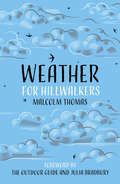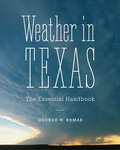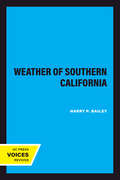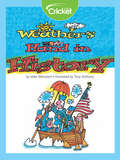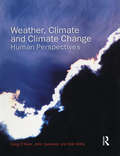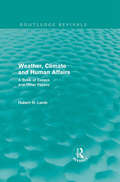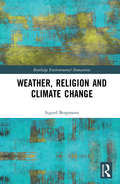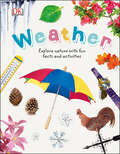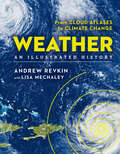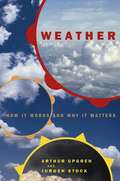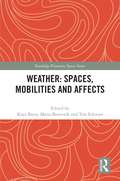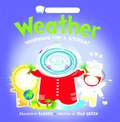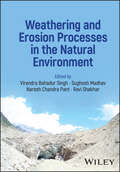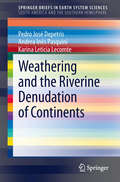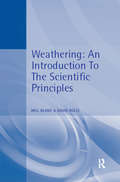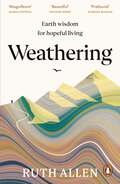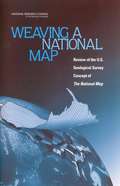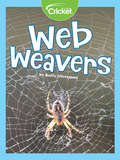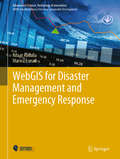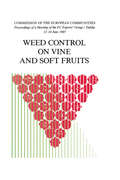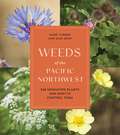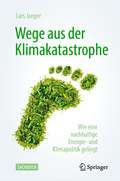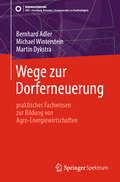- Table View
- List View
Weather for Hillwalkers
by Julia Bradbury Malcolm Thomas The Outdoor GuideFor years hillwalkers and climbers have struggled to understand the complexities of weather systems. Written by a professional weather forecaster, Weather for Hillwalkers provides invaluable insight to the beginner and veteran alike.Now in a new edition, Malcolm Thomas offers an understanding of the principles of the elements – the causes of wind, rain, snow, cloud, fog, thunder and clear skies – and looks at how they are affected by mountains and high ground. Readers will learn the terminology of depressions, warm and cold fronts, air masses and more; how to interpret weather maps; and how to make short-term weather forecasts from observations. This is essential reading for those tackling the elements amongst the hills.
Weather in Texas: The Essential Handbook
by George W. BomarOnly in Texas could a snowstorm pelt the Panhandle at the very moment abrasive dust is scouring the Permian Basin while searing heat is wilting the Winter Garden region in the south. The state&’s large size and central location within North America subject it to a great variety of weather occurrences. Texas state meteorologist George W. Bomar has been observing Texas weather for nearly half a century, and in Weather in Texas, he provides the essential guide to all of the state&’s weather phenomena. Writing in lively layman&’s language, Bomar fully explains both how the weather works and how Texans can prepare for and stay safe during extreme weather events. He describes the forces that shape Texas weather from season to season, including the influence of tropical cyclones, frontal boundaries, El Niño, and the polar jet stream. Bomar puts specific weather events in historical context, using a ranking system to illustrate how recent droughts, snowstorms, hurricanes, flash floods, and tornadoes compare with those of previous generations. He also includes comprehensive tabulations of weather data for every area of Texas, quantifying what constitutes &“normal&” weather, as well as the extreme limits of variables such as low and high temperatures, rain days, snow accumulations, and earliest and latest freezes. With everything from the latest science on climate change and weather modification to dramatic stories about landmark weather events, Weather in Texas is a must-have reference for all Texans..
Weather of Southern California (California Natural History Guides #17)
by Harry P. BaileyThis title is part of UC Press's Voices Revived program, which commemorates University of California Press’s mission to seek out and cultivate the brightest minds and give them voice, reach, and impact. Drawing on a backlist dating to 1893, Voices Revived makes high-quality, peer-reviewed scholarship accessible once again using print-on-demand technology. This title was originally published in 1966.
Weather of the San Francisco Bay Region (2nd edition)
by Harold GilliamAn introduction to the many factors which contribute to the unique weather of the San Francisco Bay region.
Weather's Hand in History
by Mike WeinsteinWeather affects us almost every day. When it's raining, we can't play outside. Sometimes weather is even more important. Sometimes weather shapes history.
Weather, Climate and Climate Change: Human Perspectives
by John Sweeney Greg O'Hare Rob WilbyA timely and accessible analysis of one of the most crucial and contentious issues facing the world today – the processes and consequences of natural and human induced changes in the structure and function of the climate system.Integrating the latest scientific developments throughout, the text centres on climate change control, addressing how weather and climate impact on environment and society.
Weather, Climate and Human Affairs: A Book of Essays and Other Papers (Routledge Revivals: A History of Climate Changes)
by H. H. LambFirst published in 1988, this is a reissue of a groundbreaking collection of essays written by Hubert Lamb, one of the world’s foremost experts on weather and climate and a uniquely authoritative voice in the history of climatology. Hubert Lamb is able to provide a mature assessment of the effect of weather on people, and vice versa. His is a uniquely authoritative voice in the current debates about today’s environment and the prospects for the future. After a general introduction the book is divided into three parts. The first part consists of a chronological series of portraits of climate and its impact on human affairs and the environment. These extend from the warm climates of the geological past to the current drought in Africa. There are several studies of the last few centuries and, in particular, of the various effects of the so-called ‘little Ice Age’. The second part is concerned with the causes and mechanisms of climate and weather changes, including chapters discussing Christmas weather, fronts and volcanoes. In the final part Hubert Lamb looks to the future, and attempts to put into perspective some of the pessimistic forecasts currently available. The text, which is consistently authoritative but always readable, is augmented by numerous maps, diagrams and photographs.
Weather, Religion and Climate Change (Routledge Environmental Humanities)
by Sigurd BergmannWeather, Religion and Climate Change is the first in-depth exploration of the fascinating way in which the weather impacts on the fields of religion, art, culture, history, science, and architecture. In critical dialogue with meteorology and climate science, this book takes the reader beyond the limits of contemporary thinking about the Anthropocene and explores whether a deeper awareness of weather might impact on the relationship between nature and self. Drawing on a wide range of examples, including paintings by J.M.W. Turner, medieval sacred architecture, and Aristotle’s classical Meteorologica, Bergmann examines a geographically and historically wide range of cultural practices, religious practices, and worldviews in which weather appears as a central, sacred force of life. He also examines the history of scientific meteorology and its ambivalent commodification today, as well as medieval "weather witchery" and biblical perceptions of weather as a kind of "barometer" of God’s love. Overall, this volume explores the notion that a new awareness of weather and its atmospheres can serve as a deep cultural and spiritual driving force that can overcome the limits of the Anthropocene and open a new path to the "Ecocene", the age of nature. Drawing on methodologies from religious studies, cultural studies, art history and architecture, philosophy, environmental ethics and aesthetics, history, and theology, this book will be of great interest to all those concerned with studying the environment from a transdisciplinary perspective on weather and wisdom.
Weather: Explore Nature with Fun Facts and Activities (Nature Explorers)
by DKHow is a forecast predicted? What makes a rainbow? Packed with facts and activities, this book has these answers and more, and is a perfect introduction to the world of sun, snow, and rain for kids who are curious about nature.With amazing facts about fun topics like thunder and lightning, Weather lets kids have fun and be innovative as they learn through simple activities like cloudspotting and making a barometer. It includes information on weather found in every season of the year, so kids can discover how weather works no matter what it's doing outside.With its natural look and feel and its practical approach, Weather is sure to make learning a breeze for little explorers.Series Overview: DK's revised Nature Explorers series is a fantastic first set of books on the great outdoors for children ages 6 to 8. From birds to weather to the seashore and more, the key topics of each subject are explained with plenty of fun activities to do along the way, encouraging kids to investigate and record everything they see. Fully updated with a contemporary design, DK's Nature Explorer series is perfect for kids who are curious about the world outside and want to discover nature.
Weather: From Cloud Atlases to Climate Change (Union Square & Co. Illustrated Histories)
by Andrew Revkin Lisa Mechaley&“Beautifully illustrated . . . Think of this book like dining on tapas, boasting savory flavors, some unexpected, that constitute a satisfying whole.&” —Washington PostAndrew Revkin, strategic adviser for environmental and science journalism at the National Geographic Society and former senior climate reporter at ProPublica, presents an intriguing illustrated history of humanity&’s evolving relationship with Earth&’s dynamic climate system and the wondrous weather it generates. Colorful and captivating, Weather: An Illustrated History hopscotches through 100 meteorological milestones and insights, from prehistory to today&’s headlines and tomorrow&’s forecasts. Bite-sized narratives, accompanied by exciting illustrations, touch on such varied topics as Earth's first atmosphere, the physics of rainbows, the deadliest hailstorm, Groundhog Day, the invention of air conditioning, London&’s Great Smog, the Year Without Summer, our increasingly strong hurricanes, and the Paris Agreement on climate change.Written by a prominent and award-winning environmental author and journalist, this is a groundbreaking illustrated book that traces the evolution of weather forecasting and climate science.
Weather: How It Work and Why It Matters
by Arthur Upgren Jurgen StockScientists have delved deep into the smallest particles of matter and have extended their view to the far reaches of the universe, but still they are unable to predict the temperature five days hence. In this intriguing book, two experts in meteorology and astronomy take us on a grand tour of Earth's weather. Amid colorful anecdotes of the Galápagos, Siberia, and places closer to home, they describe the factors involved in shaping our weather, from humidity and prevailing winds to air-pressure systems and the causes of seasonal change. They also explore the history of Earth's climate and its pivotal role in the development of life and human evolution. The authors end with a discussion of the major threats to Earth's atmosphere brought on by human activity, including global warming and ozone depletion, and argue that pure science-not politics-should dictate our policy responses.
Weather: Spaces Mobilities And Affects (Routledge Planetary Spaces Series)
by Tim Edensor Weather Spaces Maria BorovnikThis book delves into the everyday spaces, diverse mobilities and affective potency of weather. It presents cutting-edge research into the multiplicity of weather phenomena and analyses the lived experiences of humans in conjunction with contemporary issues, notably climate change. The book considers how everyday experiences of weather in the mundane lives of people are linked to broader changes in weather patterns and climate change. Heat, dust, ice, snow, precipitation, sunlight, clouds, tides and fog are states of weather that impact on the ways in which humans become intertwined with landscapes. Our experiences with weather are diverse and ever-changing, and engaging with weather entangles humans with mobilities, materials and landscapes. This book thus explores affective and sensory resonances, drawing upon a variety of theoretical, empirical and creative material to investigate how weather is perceived in different social and cultural contexts. Key themes focus on the mobilities generated by weather, the affective and sensual potency of weather, and the diverse cultural forms and practices that exemplify how weather is historically, geographically and artistically represented. Offering a social and cultural understanding of weather events, this book contributes to a growing literature on weather across various disciplines, including human geography and cultural geography, and will thus appeal to students and scholars of geography, sociology, humanities, cultural studies and the arts.
Weather: Whipping Up a Storm! (Basher Basics Series)
by Dan GreenWelcome to the wild world of weather, Basher style! Meet Hurricane, a violent blusterer; Atmosphere, a many-layered character who keeps the planet cozy; hard-nut Hail and sneezy Sleet; Drought, the dusty fellow who makes life hard for animals, plants and people; and mischievous El Nino, who messes around with ocean currents to chaotic effect.
Weathering and Erosion Processes in the Natural Environment
by Sughosh Madhav Virendra Bahadur Singh Naresh Chandra Pant Ravi ShekharWeathering and Erosion Processes in the Natural Environment An indispensable introduction to the key environmental processes of weathering and erosion Natural and human-induced weathering processes can have a great impact on soil and groundwater quality. With climate change and other environmental challenges placing increased emphasis on these resources, it has never been more important for researchers and environmental professionals to attain detailed knowledge of weathering and erosion processes. Weathering and Erosion Processes in the Natural Environment meets this need with a rigorous, systematic overview. Beginning with a description of different forces and processes that contribute to weathering, it then discusses the different kinds of landforms that can be produced by weathering and erosion processes, as well as the potential impacts of hydrogeological processes on both surface water and groundwater. The result is a volume that balances qualitative and quantitative understanding of this crucial subject. Weathering and Erosion Processes in the Natural Environment readers will also find: Documented examples in which weathering and erosion processes have led to heavy metals and other trace elements in groundwater Detailed discussion of climate change impacts, including extreme weather events and rising carbon dioxide levels Modeling approaches throughout to enable quantitative assessment and predictions of future impact Weathering and Erosion Processes in the Natural Environment is ideal for researchers and advanced students in geology, geochemistry, hydrogeochemistry and environmental science, as well as professionals dealing with water and soil management.
Weathering and the Riverine Denudation of Continents
by Pedro José Depetris Andrea Inés Pasquini Karina Leticia LecomteIn this monograph the authors present an overview of the state-of-the-art and use examples or case histories to illustrate the combined role of rock decay and rivers on continental denudation. The Earth's surface dynamics would not be conceivable without the fundamental component of rock weathering and the subsequent transport of solid debris and dissolved components to the coastal ocean through riverine drainage pathways. In other words, continental wear away is highly dependent on the mechanisms that control mineral decay. Moreover, besides the significant role played by rivers in shaping the Earth's outer skin, there is the important function that rivers perform in all geochemical cycles, mediating between the lithosphere, the hydrosphere, the biosphere and the hydrosphere. Drainage basins and the weathering of rocks that occur therein may be significant sources (or sinks) of carbon dioxide and, hence, play a significant role in affecting the Earth's climate.
Weathering: An Introduction to the Scientific Principles
by Will J Bland David RollsOur landscape is constantly changing, but before the dramatic effects of erosion and mass movement take place, more subtle forces work on the rocks, minerals and soils around us. Weathering is the initial process which exposes the top few layers of the Earth to the potential for change. This book provides an introduction to the scientific principles behind mechanical, chemical and biological weathering. Starting with a consideration of the chemical and physical properties of rocks and water, the authors proceed to an accessible explanation of the weathering processes themselves, concluding with a review of weathering rates and intensities, and a survey of the effects of weathering on the landscape. Assuming little background knowledge, the authors develop ideas from first principles to provide a straightforward introduction to weathering for students of geography, geology and earth and environmental science.
Weathering: How the earth's deep wisdom can help us endure life's storms
by Ruth AllenRocks and mountains have withstood aeons of life on our planet - gradually eroding, shifting, solidifying, and weathering. We might spend a little less time on earth, but humans are also weathering: evolving and changing as we're transformed by the shifting climates of our lives and experiences. So, what might these ancient natural forms have to teach us about resilience and change?In a stunning exploration of our own connection to these enduring forms, outdoor psychotherapist and geologist Ruth Allen takes us on a journey through deep time and ancient landscapes, showing how geology - which has formed the bedrock of her own adult life and approach to therapy - can offer us a new way of thinking about our own grief, change and boundaries.In a world shaken by physical, political, and medical disasters, Weathering argues for a deeper understanding of the ground beneath our feet to better serve ourselves and the world we live in.
Weaving a National Map: Review of the U.S. Geological Survey Concept of The National Map
by Committee to Review the U.S. Geological Survey Concept of The National MapWeaving a National Map draws on contributions to a September 2002 workshop and the U.S. Geological Survey's (USGS) "vision" document for The National Map, envisioned by the USGS as a database providing public domain core geographic data about the United States and its territories that other agencies can extend, enhance, and reference as they concentrate on maintaining other data that are unique to their needs. The demand for up-to-date information in real time for public welfare and safety informs this need to update an aging paper map series that is, on average, 23 years old. The NRC report describes how "The National Map initiative would gain from improved definition so that the unprecedented number of partners needed for success will become energized to participate. The challenges faced by USGS in implementing "The National Map are more organizational than technical. To succeed, the USGS will need to continue to learn from challenges encountered in its ongoing pilot studies as well as from other federal-led programs that have partnered with multiple sectors.
Web Weavers
by Buffy SilvermanGarden spiders belong to a group called orb weavers, which spin wheel-shaped webs. Some webs are funnel-shaped and some are very sticky. In this photo essay about different kinds of spider webs, readers will learn all about nature's masters of silk weaving.
WebGIS for Disaster Management and Emergency Response (Advances in Science, Technology & Innovation)
by Rifaat Abdalla Marwa EsmailThis book aims to help students, researchers and policy makers understand the latest research and development trends in the application of WebGIS for Disaster Management and Emergency Response. It is designed as a useful tool to better assess the mechanisms for planning, response and mitigation of the impact of disaster scenarios at the local, regional or national levels. It contains details on how to use WebGIS to solve real-world problems associated with Disaster Management Scenarios for the long-term sustainability. The book broadens the reader understanding of the policy and decision-making issues related to Disaster Management response and planning.
Weed Control on Vine and Soft Fruits
by Commission of the European CommunitiesThis book demonstrates the common problems faced by fruit growers throughout the Community and shows the importance of weeds in fruit crops. It summarizes a list of the worst weeds in vine and soft fruits in each European Country.
Weeds of the Pacific Northwest: 368 Unwanted Plants and How to Control Them
by Mark Turner Sami GrayA comprehensive guide to the most common weeds of the Pacific Northwest, with essential information on their management and eradication Weeds are everywhere. They crowd out valuable agricultural crops, compete with the tomatoes and beans in your vegetable garden, spread rampantly along roadsides, and pop up from the tiniest cracks in sidewalks. In order to manage them, we must first learn how to identify them. Weeds of the Pacific Northwest is a guide to identifying, controlling, and eradicating over 300 species of weeds that gardeners and homeowners are likely to encounter in Northern California, Oregon, Washington, and British Columbia. Though they can all cause trouble, each weed is different. The hundreds of user-friendly photographs and detailed descriptions of each species here ensure that you can spot and treat any weed in your path. As the experts behind this book demonstrate, some plants can be killed by eating them, some by digging, some by smothering, and some only by the judicious application of chemical herbicides—and it is very important for you and your neighbors to know and understand the differences.
Wege aus der Klimakatastrophe: Wie eine nachhaltige Energie- und Klimapolitik gelingt
by Lars JaegerÜberschwemmungen, Artensterben, Völkerwanderungen, Dürren, Supertornados - der Klimawandel ist keine am Horizont drohende Gefahr mehr, sondern längst in unserem Alltag angekommen. Die Lage ist sehr ernst, aber wir haben durchaus Konzepte, den verheerenden Klimatrend aufzuhalten und umzukehren.Alle durch den Menschen erzeugten klimarelevanten Einflüsse lassen sich auf einen einzigen Faktor zurückführen: Energie. Wer die aktuelle Klimadynamik stoppen und sogar umkehren will, muss daher auch auf die drei zentralen Fragen zur Energie und dem Klima eine Antwort finden: Wie genau beeinflusst unsere bestehende Art des Energieverbrauchs das Klima? Welche Möglichkeiten haben wir, Energie ohne negative Klimaeffekte zu erzeugen? Welche technologischen Fortschritte werden uns dabei in der Zukunft konkret helfen?Lars Jaeger gibt einen Ausblick auf eine mögliche klimafreundliche Wirtschaft der Zukunft, beschreibt, wie eine ökologische Gesellschaft funktionieren kann und wie lokale Energiekonzepte weltweiten Erfolg haben können. Er kommt dabei mit einer klaren und optimistischen Botschaft: Wir verfügen schon heute über die technischen Möglichkeiten (und in der Zukunft umso mehr), um den verheerenden Klimatrend ohne signifikante Wohlstandsbeschränkung umzukehren. Die Hindernisse liegen vor allem in ökonomischen und politischen „Sachzwängen“ und partikulären wirtschaftlichen Interessenskonflikten. Diese zu überwinden, darum geht es in der zukünftigen Energiepolitik.
Wege zur Dorferneuerung: praktisches Fachwissen zur Bildung von Agro-Energiewirtschaften (SDG - Forschung, Konzepte, Lösungsansätze zur Nachhaltigkeit)
by Bernhard Adler Martin Dykstra Michael WintersteinVorliegendes Buch ist für Landwirte und die Bevölkerung des ländlichen Raumes konzipiert. Die Landwirte bekommen derzeit für die landwirtschaftlichen Produkte nicht den preislichen Gegenwert für ihre geleistete Arbeit. Die Bevölkerung im ländlichen Raum leidet unter der Abwanderung junger Leute und dem Zusammenbruch der Infrastrukturen. Beide Gruppen können durch eigenständiges Handeln diese Situation selbstständig und nachhaltig verbessern, denn die Ackerfläche bietet das Potenzial für zukünftige neue Produkte für die Energieversorgung. Dazu offeriert das Buch Strategien, Nahrungsmittel und Energien in Agro-Energiekomplexen zu gewinnen. Hierfür werden Synergismen bei der Produktion in der Pflanzen- und Energieproduktion auch unter dem Aspekt eines klimabedingten, temporären Wassermangels diskutiert sowie die Vorteile des Klarwassereinsatzes zur Bewässerung der Ackerböden. Nicht unerheblich scheint auch die Nutzung von Phosphat- und Ammoniumionen als Vollwertdüngemittel aus dem Abwasserrecycling. Beide obengenannten Zielgruppen erreichen eine spürbare Verbesserung ihrer Lebensverhältnisse durch die Bildung von Anbau- und Nutzergemeinschaften.
Weird Maths: At the Edge of Infinity and Beyond
by David Darling Agnijo BanerjeeIs anything truly random? Does infinity actually exist? Could we ever see into other dimensions? In this delightful journey of discovery, David Darling and extraordinary child prodigy Agnijo Banerjee draw connections between the cutting edge of modern maths and life as we understand it, delving into the strange – would we like alien music? – and venturing out on quests to consider the existence of free will and the fantastical future of quantum computers. Packed with puzzles and paradoxes, mind-bending concepts and surprising solutions, this is for anyone who wants life&’s questions answered – even those you never thought to ask.
